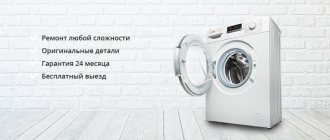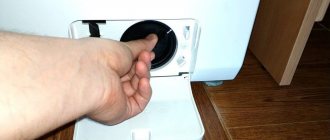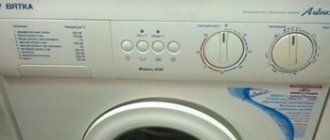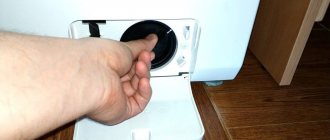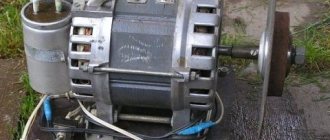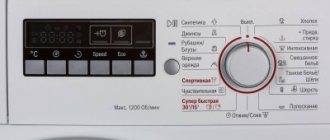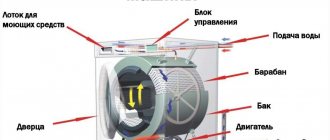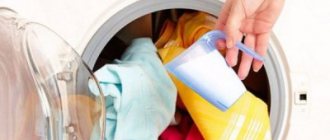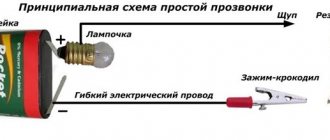Our great-grandmothers washed clothes in the waters of cold rivers, our grandmothers had to heat water to wash bed linen by hand, but we have washing machines that allow us to save a little time and spend it on more interesting activities.
Many people associate a washing machine with cleanliness, freshness and a pleasant smell. We buy expensive washing powders, fabric softeners and other special detergents to enhance the scent of freshly washed clothes. But sometimes owners of not only old, but also recently purchased washing machines are faced with the fact that their household appliances begin to emit a musty and unpleasant odor. This problem must be addressed immediately, otherwise the clothes you wash in a washing machine that emits bad odors will smell not of freshness and cleanliness, but of sewer or swamp.
Why does the washing machine suddenly appear to have an aroma that cannot be called pleasant? Is it possible to remove it at home? What folk remedies are the most effective for removing bad odors from a washing machine? What preventive measures should be taken to prevent the appearance of rotten, moldy and damp odors? Today we will discuss these and many other important issues related to this sensitive topic.
Sources of unpleasant amber
First of all, you need to find out why the washing machine stinks and find the source of the accumulation of “odors.” The causes of a putrid, musty, moldy odor are bacteria, fungi, and mold. Representatives of the microcosm feel great in a warm, humid, dark environment, which is the washing machine.
Microorganisms can settle not only in the centrifuge, but also in the internal parts of the mechanism, drains, and hoses. Any place that comes into contact with moisture is a potential environment for the development of organisms. To detect and eliminate settlements of bacteria and fungi, you should know their habitats, as well as follow simple rules for operating a washing machine.
Our mistakes
Often the cause of an unpleasant odor is the incorrect actions or inaction of the housewife. If a musty smell comes from the washing machine just a few months after purchase, it means that the owner is not aware of the operating rules or is being negligent in relation to the equipment. By analyzing your actions while using the machine, you can eliminate the unpleasant odor factor to keep the equipment clean. What are housewives doing wrong? Typical errors are described in the table.
Table - Erroneous actions when operating washing equipment
| Action | Description | Problem |
| Closing the hatch | — Door slamming immediately after removing washed items | — Retention of moisture on the surface of the centrifuge due to its incomplete evaporation; — the emergence of a “greenhouse effect”; - favorable environment for the development of fungi and bacteria |
| Storing dirty laundry | — Loading a wet drum with dirty laundry, leaving things inside for a long time | — Creating an environment for microorganisms to thrive |
| Wash at low temperatures | — Using only one mode with a set temperature below 40°C | — Incomplete dissolution of the powder, poor leaching from clothes; — the appearance in the inside of the machine (on the drum, hoses, filters) of powder “spots” on which bacteria settle; — creating an environment for the proliferation of microorganisms that low temperatures do not kill |
| Wash at high temperatures | — Using only one mode with a set temperature above 60°C | — Accumulation of plaque during frequent washing at high temperatures (above 60°C); - the appearance of a burning smell, which is emitted by large deposits when the machine is operating at high temperatures |
| Use of low-grade powders | — Buying cheap powder and rinse aids without special additives that protect against scale | — Poor dissolution of cheap powder products; — accumulation of soap residues inside the hoses; - formation of plaque or scale on surfaces, inside the drum, hoses |
| Negligence when loading clothes | — No checking of pockets before loading into drum | — Rendering of various items not taken out of pockets into disrepair (including passports and money); — breakdown of equipment due to clogged filters and tubes; - the appearance of a putrid odor when small debris (napkins, cigarettes, sweets) settles in the internal parts |
| Ignoring filter cleaning | — Lack of periodic washing of the drain and inlet filters, which are responsible for preventing odor and preventing breakdowns | — Retention and accumulation of large particles in clogged filters - hair, dust, debris; - appearance of an unpleasant odor |
| Using hard water | — Reluctance to use special products for water softening, cleaning hoses, drain holes | — Formation of plaque on a tubular electric heater (TEH); — the appearance of scale due to the deposition of salts from the central water supply, the adhesion of fluff; — formation of plaque from residual detergents and small debris; - settling of a large amount of dirt |
| Leaving the centrifuge wet | — Reluctance to wipe the rubber lining and tray dry, or to rinse the powder receptacle | — Germination of mold and mildew due to constant humidity |
Favorite places for bacteria
To eliminate unpleasant odors in your washing machine, you should know the places where the smell comes from. Bacteria, fungi, and mold actively multiply in certain parts of the machine. Usually these are hard-to-reach places, folds, narrow crevices. When checking and cleaning equipment, you should pay attention to the “favorite” places of microorganisms:
- receptacle for laundry detergents (pull-out trays);
- a channel behind the receiver, providing access to the powder and conditioner inside;
- rubber lining around the door;
- filters - for water inlet and outlet;
- drain hose;
- heating tube.
Almost all parts of the machine can be checked at home yourself, without resorting to special tools or calling a specialist. The tray can be easily removed by pressing a special blue valve and washed with cleaning agents and water. The channel can be clearly seen with a flashlight and can be cleaned with a small brush. The sealed pad and centrifuge are always accessible. The filters are removed, cleaned, and then put back in.
When should you call a plumber?
If you can’t get rid of the smell in your washing machine on your own, call a plumber. During the diagnostic process, it sometimes turns out that there is a breakdown in the car.
A specialist will inspect the washing machine, find the cause of the bad odor and correct the problem:
- clean and disinfect the rubber door seal;
- wash the drain pump filters;
- clean the powder tray;
- removes scale from the heating element;
- will replace the heating element with a new one if necessary.
Tips for Extending Lifespan
To eliminate problems and extend the life of household appliances, experts recommend following five rules.
- Storing clothes in a basket. Dirty laundry should be placed not in the drum, but in special baskets. Moreover, the storage container must allow air to pass through, otherwise bacteria will begin to accumulate on the wet, soiled fabric.
- Alternating temperature conditions. Fans of “quick washing” should alternate short cycles with long ones, once a week change the temperature from 40 to 60-80°C, and at least sometimes wash on a full cycle at 90°C.
- Use suitable powder. It is recommended to use powders intended only for vending machines, observing the exact dosage. You can use liquid products, which, as a rule, are washed away without leaving a residue.
- Washing filters. Filters should be cleaned periodically. The inlet filter is located inside the water supply opening and should only be removed after turning off the taps. The drain filter is located at the bottom, on one of the walls of the machine. Before unscrewing it, you need to place a rag or a low basin - a lot of water usually pours out of the hole.
- Using descaling products. You should soften the water and periodically use cleaners for heating elements. Expensive powders already contain agents that protect heating elements and parts, so additional cleaning is required no more than once a week.
The owners of the car are not always at fault. Often, unskilled technicians incorrectly connect equipment to the drain, and some of the waste water remains inside the hoses. This can happen when the machine is installed at an angle. If the hose is kinked or connected too high, then the center of the stench is most likely located here. In addition, the smell can come from the drain if there is a clog in the drain. “Aromatic” amber is emitted by the sink, bathroom, and other plumbing fixtures in the house.
How to replace the rubber hatch cover
If mold remains in the washing machine after cleaning the cuff, then you will have to replace it. In order for such a replacement to be successful, you must first of all buy not just a similar one, but one specifically designed for your model, and only after making sure of their identity proceed with the replacement.
The method of attaching the cuff to the machine varies from model to model, and the method of detachment will also vary.
One will be for plastic clamps, the other for metal ones, secured with latches, springs or screws. Therefore, read the instructions carefully.
How to get rid of smell from an automatic washing machine: professional and home remedies
The rotten smell from the washing machine is removed using special or improvised cleaners. Usually the substances are loaded into the machine's receiver, but sometimes they are placed directly into the drum or used for wiping.
The easiest way is to go to a hardware store to choose a suitable cleaner that will professionally help get rid of the damp smell from the washing machine. Prices vary, so you should pay attention to the composition: most often it is the same. The products are sold in the form of tablets, powders and liquids. The most popular cleaners:
- "Antiscale";
- "Multidez-teflex";
- Beckmann;
- Frisch Aktiv;
- Magic Power;
- Kaneyo;
- Nagara;
- Luxus Professional;
- Frau Schmidt;
- Topper 3004.
Folk remedies that can be found in the kitchen or pantry will help you save. Compared to those specially designed for washing machines, the price of improvised substances is noticeably lower. At the same time, home cleaners are in no way inferior to professional cleaners in terms of effectiveness.
Frau Schmidt
- Remove the protective film from the washing machine and dishwasher cleaning tablet.
- Place the tablet in the drum.
- Set the temperature to 60°C.
- Run a normal cycle without pre-soaking.
Dr. Beckmann
- Pour 250 g of washing machine cleaner into the centrifuge.
- Set the temperature to at least 60°C.
- Run the normal cycle without spinning or pre-washing.
"Multidez-teflex"
- Pour 100 ml of product into the receiver.
- Place a cotton cloth in the centrifuge.
- Run a normal wash cycle at 60°C.
Bleaching
- Pour 100 ml of bleach or other chlorine-containing substance into the centrifuge.
- Set it to 90°C.
- Run a short cycle (about 30 minutes).
Acetic acid
- Pour 50-100 ml of vinegar into the tray (the amount of acetic acid depends on the volume of the washing machine).
- Set it to 60°C.
- Run the longest cycle.
- To achieve the best effect, interrupt the cycle and restart the machine after an hour.
"Limonka"
- At the rate of 100 g per 6 kg of machine load, pour citric acid into the receiving tray instead of powder.
- Set the temperature to 90°C, no need to spin.
- Run a full cycle.
- When the cycle has completed the first half, unplug the machine and leave it overnight.
- In the morning, turn on the machine and continue the cycle.
Soda powder
- Pour a glass of baking soda into a glass of warm water.
- Soak a sponge or paint brush with the resulting paste and clean the moldy accessible areas.
- Place 200g baking soda powder in the tray.
- Start the boiling mode.
- After completing the cycle, run an additional rinse.
Copper sulfate
- Dilute 50 g of vitriol in 100 g of warm water.
- Stir, pour into the drum.
- For deep cleaning, add some of the solution to the tray.
- Set it to 90°C.
- Run the cycle for 30 minutes.
Sometimes after using the products the smell does not disappear, but only intensifies. This does not mean that the remedy did not work or made the situation worse. Most likely, there is heavy dirt inside the car, and the product has only slightly corroded them (hence the increased smell). To completely eliminate dirt and odor, it is necessary to run several cycles of cleaning agents (five to six times). Remembering that any acid has a detrimental effect on machine parts, it is better to alternate products: one cycle with a small amount of acid, the second with alkali.
Reviews from washing machine owners
Prices for popular models of washing machines
Washing machines
According to consumer reviews, the surest way to get rid of an unpleasant odor is to manually clean individual elements of the machine using professional or folk remedies. Users note the effectiveness of the specialized Beckmann product, which removes odor in one use. They wipe the powder compartment, drum, rubber part with it, and then pour it into the machine and turn on the dry wash. Also an excellent remedy is Magic Power, which will not only remove the odor, but also quickly cleanse the elements of multi-layered scale.
Consumers and washing machine technicians note that some advertised products are not suitable for eliminating odors and dirt because they are preventative. For example, “Calgon”, which can only soften water in order to prevent the development of sediments. But it will not be able to deal with existing dirt and odors. You can save on such preventative agents by using washing powders with special components (phosphates) that protect against the formation of deposits (Tide Avtomat, Persil, “MYTH”, and so on).
Among folk methods, citric acid and soda are recognized means for eliminating odor. Combining the latter with vinegar allows you to remove pronounced deposits and persistent odors.
Preventative measures for using the machine play an important role in maintaining the freshness and pleasant aroma of laundry. Proper and regular cleaning of the elements of a household appliance will not only avoid unpleasant odors, but will also ensure a long service life.
Things to remember
When using various substances, you must follow four rules in order to effectively remove the smell from the washing machine and not harm the equipment or your health.
- Rinse. Deodorizers for washing machines are quite caustic and odorous. Therefore, after using the substances, it is necessary to rinse the car using a full cycle. The entire cleaning process is carried out empty, without loading laundry.
- Use of bleach. According to many housewives, chlorine-containing substances are not the best means for getting rid of odors. Bleach disinfects, kills bacteria, but at the same time leaves its corrosive chemical smell. Running several cycles without laundry or with unnecessary items will help remove the smell. It is also necessary to ventilate the room where the car is parked. If you are individually intolerant to the chlorine smell, it is better to avoid such cleaners.
- Combination of chemicals. Some products can be used together to enhance the effect, given that alkali neutralizes acid. The main thing to remember is not to use bleach and drain cleaner at the same time. As a result of their chemical reaction, toxic chlorine is released.
- Periodicity. Cleaning with acetic acid must be carried out once every six months, with citric acid - once every four months. Industrial products should be used strictly according to the instructions on the label, observing the recommended dosages and timing of the procedure.
What to do if things smell rotten after washing?
While the issue of cleaning the washing machine is being resolved, I would like to remove the unpleasant aroma from the washed items. Does your laundry smell after washing? A weak solution of vinegar will help. For white items, you can use a suitable antibacterial agent, for example, Domestos. After treatment, rinse thoroughly and dry things in the sun. When hanging clothes, try to straighten out all the folds for better contact with air. After this, the laundry smells fresh and clean.
Preventive measures
An excellent way to prevent odor is the self-cleaning function, which, unfortunately, is not built into all models. If your machine has a self-cleaning cycle, you should run it about once a month. Automatic cleaning will save you from unnecessary hassle.
In the absence of a special function, odor from the washing machine drum can be prevented by following the operating instructions and periodically performing preventive measures. Only five parts need to be cleaned.
Interior of a centrifuge.
- Wipe dry after the end of the cycle.
- Sealed linings. Wipe after removing clothes, clean once a week.
- Detergent receptacle. Wash once a week.
- Feed channel. Clean it with a brush every month.
- Filters. Clean thoroughly once every two weeks if the machine is used frequently.
To maintain the “health” and cleanliness of the drum, it is necessary to use a water softener (laundry soap, Calgon, soda powder), which is added to the tray with the powder or conditioner with each wash. It is also recommended to run the machine once every three to four weeks at a high temperature (not lower than 90°C) for a full idle cycle.
If all methods on how to remove the smell from an automatic washing machine have been tried, but the smell remains, you will have to contact a specialist. In some cases, only replacing parts will save you from an unbearable odor. Usually, a sealed lining eaten away by mold, a heating element, and a clogged drain hose are replaced. The operation to replace parts will be carried out professionally by a specialist.
Video on the topic
Odor prevention
Following the rules for using a washing machine and regular cleaning will prevent the occurrence of stench and other problems with the household appliance:
- Clean the rubber rim and powder compartment weekly.
- Clean the filter monthly.
- After use, wipe accessible elements dry and keep the hatch slightly open.
- Buy high-quality detergents (preferably with phosphates), do not exceed their norm.
- Periodically run the machine idle on a high temperature program.
- Keep debris out (check pockets). Wash items with lint in a special bag.
- Do not store dirty laundry inside the appliance.
Prevention of unpleasant odor
